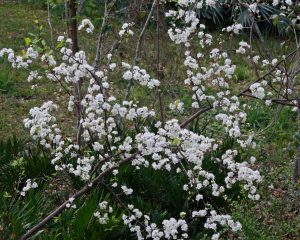Flatwoods Plum, Prunus umbellata

Photo by Mary Keim

Photo by John Ruter, University of Georgia, Bugwood.org
Height: 15-20 feet, sometimes taller
Spread: 15-20 feet
Flatwoods plum is sometimes called the “forgotten” plum, because it has been largely overlooked or ignored. It is a beautiful and useful deciduous tree that deserves far more use and recognition. Native to both pine and hardwood woodlands of average drainage in much of Florida, except the extreme southern counties, it is sometimes confused with the Chickasaw plum (P. angustifolia). The differences between the two species are many, however. Flatwoods plum is a somewhat-crooked single trunk tree. It’s often as broad or broader than tall, but can be more tree form like. The leaf blades are flat, not slightly folded, and lack the small red glands on the marginal teeth. The white flowers bloom in late spring, often several weeks later than those of Chickasaw plum, and the somewhat smaller, ½-inch red to yellow fruit ripen to dark purple several weeks later in summer. Flatwoods plum is not salt tolerant and rarely armed with thorny spur shoots. This plum is best used as an understory tree in a woodland landscape where it receives filtered or partial sun. If planted in full sun, it grows best in locations that receive a bit of extra moisture. Flatwoods plum almost never suckers and is thus far easier to control in a landscape than Chickasaw plum, and deserves wider use. It occurs naturally throughout the southeastern Coastal Plain and Piedmont ecoregions of Georgia, South Carolina, Alabama, Mississippi, Louisiana and even eastern Texas.
WILDLIFE VALUE: Like all of our native plums (aka wild cherries), this tree is vital for many butterfly and moth species, which in turn feed migrating birds. The fruit is also extremely important bird food and really, food for all kinds of wildlife and for people.
-Much of the above text taken from Native Plant Landscaping for Florida Wildlife by Craig N. Huegel Craig is a fan of plums and haws and other great native wildlife plants, and is himself a wonderful native plant educator.